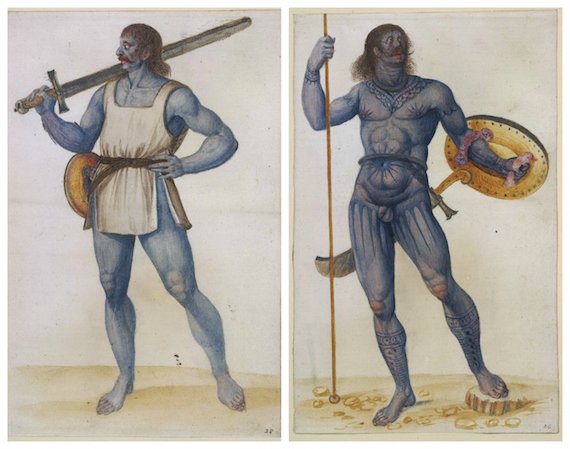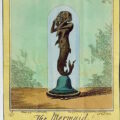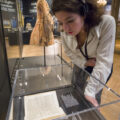European Make up History – pt 1
March 15, 2016Make up has just about always been used. For almost as far back as historians can reach, they’ve found cosmetic pots and other evidence that our forebears liked to decorate not only their homes and sacred objects with paint, but their bodies and faces too. This is a brief history of European make up.
The Picts and European Make up History
In about the 1st century AD, the Romans came to conquer what is now Britain. In current day Scotland, they spoke of native tribes etched in blue – they called them the Picts. (“Painted or tattooed people” from Latin pictus, “painted”.) There is some debate about whether this painting was the sort which washes off or if they were actually permanently tattooed, but in any case, the designs included the whole body and face and followed the lines of muscles and curves on the body. You will probably recognise the artwork style – it’s part of the basis for the “Celtic” tattoos that were wildly popular in the ‘90s. Two differences with the Pictish tattoos though – their designs held meanings, and they were always indigo.
The colour came from woad, a plant which is a relative of the mustard family. The flowers are yellow, but when the leaves are processed they produce a beautiful dark blue dye. The Picts could also make a red dye from a plant called Madder, and a yellow dye from Weld. But it was blue they wore on their skins, perhaps picked because it was a strong contrast to their natural colouring – as unnatural as they could get.
Romans
In contrast, their Roman conquerors chose make up that looked natural – or at least, colours that echoed nature. They liked white foundation, red lips and cheeks, dark grey for eyeliner and black for eyebrow enhancement. Oh, and a little flash of yellow or green eyeshadow. Yellow was made out of saffron or yellow ochre from clay and green from powdered malachite, a semi precious stone – a little trick which they learned from the Egyptians. I’m not sure why they stuck with just the bright green and yellow though (Egyptians just used green) when they had access to other semi precious stones like lapis lazuli – a lovely bright blue seen on Egyptian mummy cases; turquoise, red garnets, orange carnelian, green emeralds, white pearls, black obsidian and glittering rock crystal – if they’d used all of those then glam rock might have come 2,000 years early.
We don’t know that much about Pictish society and if they had different classes in society and if so, which were painted, but in Roman society all classes of women used make up. The higher up you were, the more you used. Upper class women had a whole beauty routine worked out, starting with taking steam baths and saunas, applying moisturising cream, then their make up and elaborate coiffures. They employed many skilled slaves – sometimes thousands – to be their bath attendants, hairdressers, make up artists, and to prepare their lotions and potions. These were kept in fine decorated pots made from glass, marble or semi precious stones. However, cosmetic pots have been discovered in the graves of the poorest citizens of Rome. Theirs were simple wooden or clay dishes, sea shells or even fragile egg shells.
Men
On the subject of gender, although globally both men and women have worn make up, in European make up it was mostly worn by women in mainstream circles . Men contented themselves by having various opinions on it and how it reflected on its wearer’s morality. “A Painted Woman” has long been a synonym for a prostitute, and sometimes, a woman with heavy use of make up was unfavourably compared to one. But sometimes heavy make up was reserved for the highest social circles, as above.
Of course, there have always been men who deliberately wanted to look feminine, and used make up cosmetics to do so. The other exceptions were the male peacocks at the 17th century court of Louis XIII in France, the 18th century English Macaronis, and the 19th century English dandies, none of whom were above a bit of flamboyant face powder and rouge.
The colours of European Make up History
Before the 20th century cosmetic colours were restricted to those that could be extracted from animals, plants and minerals, but scientific formulas were quite sophisticated and various compounds were added to stabilise cosmetics or even add value – there are medicinal ingredients in Ancient Egyptian eyeliner that suggest it wasn’t just used to give big, beautiful eyes but to protect against both the glaring sun and bacterial eye infections.
The Roman’s little flash of green or yellow was about as wild as it got, cosmetic wise, and I can’t think of a European culture that went all out on the colours for face paint since. Of course, African nations, Brazilian tribes and others across the globe had and still have amazingly inventive body and face paints in all colours and configurations, but in European make up we seem to have stuck with a palette of black,red and white.
Black in European Make up History
Black has mostly been used in European make up to define the eyes, enhance the eyebrows, and for beauty spots. The Ancient Greeks liked the Frida Kahlo look, so they used burnt cork or soot to fill in their eyebrows and make them connect across the bridge of their noses.
Kohl and eyeshadow have also been made from soot or ashes bound with animal fat, or a mineral called galena, a dark grey ore of lead.
The Romans used stick on beauty spots called splenia to cover blemishes, but the whole beauty spot thing took off in European make up at the end of the 16 century. Women would have already coated their faces in foundation to help hide uneven pigmentation, scars and splotches, but of a spot was really bad, the French stuck a black velvet mouche on it.
These tiny patches could be made in satin or leather as well as velvet, and they came in circles, hearts or stars. Where they were positioned was important, so you had to hope you didn’t get a raging spot just by your mouth, as a mouche there meant you were single and on the prowl. If you wore a beauty spot by the corner of your eye, you were a mistress. The right cheek was for married people, the left for single.
By the eighteenth century, standards in European make up had slipped, as Henri Misson wrote in 1719: “The Use of Patches is not unknown to the French ladies, but she that wears them must be young and handsome. In England, young, old, handsome, ugly, all are bepatch’d… I have often counted fifteen Patches, or more, upon the swarthy wrinkled face of an old Hag threescore and ten, and upwards”.
Red in European Make up History
Red echoes the natural flush of cheeks and lips, and as blood rushes to these areas when a person is aroused, it gives the impression of sexiness. Red cosmetics have mostly been limited to these areas; sometimes it is applied on the fingernails, and occasionally used around the eyes too. There has been a whole palette of red and pink cosmetic colours popular in makeup history, from pale pastel pinks, bold hot pinks, scarlet, berry red and purple, so although modern dyes with their brilliant colours were not invented till the 19th century, there has been quite a lot to play with.
Red has been made from crushed strawberries, beetroot or other berries; from red ochre extracted from clay or simply red clay itself; from dried and ground beetles to create cochineal, or it has been extracted from safflowers and alkanet root. Henna was also used to create red shades on hair, skin and fingernails. Don’t make the mistake of thinking that all European make up was organic and good for you, or at least harmless though – red lead, cinnabar and mercuric sulphide were also used, and were extremely poisonous.
Madame de Pompadour, the famed 18th century mistress of King Louis XV of France loved pink blush so much that “Pompadour Pink” was named after her. Queen Marie Antoinette of King Louis XVI of France also famously favoured the pale skin and big circles of pink blush look.
White in European Make up History
A pale complexion in European make up has historically been favoured. White skin indicates that you have been protected, that you never had to go outside working in the fields. It is also feminine, because whatever your DNA, female skin has always been a shade or two lighter than males. As well as this, the skin darkens both over time, due to inevitable skin damage, and also after giving birth, when pigmentation increases slightly. So a white skin implies that you are a young virgin. A clear complexion, without visible ruddiness, spots or scars, also suggests that you are healthy and free of, say, the pox.
So, to create this white complexion, everything from a light dusting of rice powder or cornstarch to a heavy enamelling of egg white primer covered with lead paint has been used.
The lead paint, used in the 17th and 18th century (think of the iconic image of Elizabeth I) even had delicate blue veins painted on top to make the skin look translucent. The really sad thing about this lead coating, which was both fashionable and quite expensive, was that it literally rotted your skin so the more you used it, the more you would need to use to cover the damage. “Ceruse or white Lead… transform(s) humane creatures, of fair, making them ugly, enormous and abominable… a man might easily cut off a curd or cheese cake from either of their cheeks.” wrote Thomas Tuke in 1616, in A Treatise against Painting and Tincturing of Men and Women, and he wasn’t exaggerating.
Dreadful drinks for a pale face
As well as coating the face, various concoctions were ingested to promote a pallor. In Victorian times in Britain, women wanted to look pale and interesting, but not healthy. This was because the poets of the time loved the idea of the consumptive female with not long to live. The beauty idol of the day was Elizabeth Siddal who started out quite pale because she was a red-head, but was perfectly healthy until she caught a cold while posing in the bath one day and things went downhill from there.
The painter Ford Maddox Brown wrote in 1854 that he “Saw Miss Siddal looking thinner and more deathlike and more beautiful and more ragged than ever, a real artist, a woman without parallel for many a long year.” Overt European make up was unladylike so women who wanted the look drank chalk and vinegar, which repressed the appetite and probably made you look a queasy pale green colour too. They also stayed up late reading to get dark circles, and some resorted to smudging a tiny bit of rouge around the eyes to look properly poorly.
In fact, in Victorian times actual killer diseases and malnutrition was rife. I imagine that all those seamstresses straining their eyes overnight, using one candle to get a dress finished for those vinegar-drinking ladies might already have the pale and interesting look and possibly even consumption, and might have envied those women their good health. Never mind, if the ladies were very lucky an infectious disease might be passed on to them through their slaved-over gowns. (It did happen).
Beauty recipes
There were also preparations added before make up to bleach the skin. Nightingale droppings and crocodile dung were two ideas, but other recipes were more complex, involving the steeping, drying and pounding of roots for days to be added to other ingredients as part of involved beauty formulations.
These recipes for home-made beauty solutions had always existed, passed down from mother to daughter or shared between women in the village. But with the rise of the printing press in the 16th century, pamphlets with beauty advice and recipes were produced. Sometimes they were sold by peddlers who also thoughtfully sold the ingredients to go with them! These pages evolved into whole books which gave cosmetic recipes alongside instructions for preparing medicine, soap and food. This would have made sense as the lady of the house was in charge of all of these things. A sort of latter-day women’s European make up magazine, really.
Victorian attitudes in European Make up History
Cosmetics were used in various degrees of visibility from the 1st century right up until the 18th. But by Victorian times, it was in very bad taste to be seen with make up on.Queen Victoria considered it vulgar, so if you wanted to be ladylike you pinched your cheeks and bit your lips to bring a bloom, and carefully prepared your skin using beauty recipes and facial exercise. A little powder was permitted, and rouge did exist commercially, but to use it obviously was to risk censure. I think this is where the hazy idea that European make up cosmetics were basically invented in the 20th Century comes from – those photos showing natural, well-scrubbed faces under severely parted hair. But it was certainly used before Victorian times, and after – well, that’s when the cosmetics explosion began.










